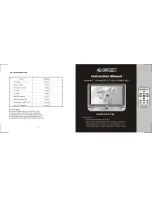
12
OPM-145/D
DC WIRING
All communication and DC wiring should be run in
separate conduit from AC wiring.
To install the wires, reference the following picture. Use a
small flat head screwdriver to push the release spring inside
the square hole (A). While the release is being pushed,
insert the wire into the larger circular hole (B). Remove the
screwdriver to secure the wire into place.
REMOTE START
The DSE7310 is able to start the generator when it receives
a remote signal from any dry contact. This makes the system
compatible with a wide range of control mechanisms
including two-wire start automatic transfer switches. When
the contact closes the controller will automatically start.
When the contact is opened the generator will go through
a cool-down cycle and turn off. Connect the remote start
leads to the Remote Start + and Remote Start - terminal
blocks in the door behind the DSE 7310 controller.
E STOPS
In some applications additional emergency stops may be
desired or necessary. The controller has terminals designed
allowing the addition of multiple remote emergency
stops. E-stops must be normally closed to work properly
in this system. The e-stop circuit supplies power to the fuel
solenoid and the starter circuit. Opening any switch in the
series prevents the engine from cranking or from receiving
fuel to run.
A
B
SCR
(DSENET)
4A
(DSENET)
4B
(DSENET)
Battery Charge Fail Emergency Stop Emergency Stop Remote S
tart +
Remote S
tart -
Ground Ground B Battery -
Two-Wire Start Hook-Ups
SCR
(DSENET)
4A
(DSENET)
4B
(DSENET)
Battery Charge Fail Emergency Stop Emergency Stop Remote S
tart +
Remote S
tart -
Ground Ground B Battery -
E-Stops
To wire additional emergency stop switches first remove
the orange jumper between the two Emergency Stop
terminal blocks. Failure to remove the jumper will prevent
the remote switches from working properly. Add wires
between the terminal block to the new switch(s). The
switches must be wired in series for proper function. Test
each e-stop after wiring to ensure they function properly.
SERIAL COMMUNICATION
DSE provides a series of remote accessories that can help
provide useful information to operators. These accessories
communicate over the DSE Net. Terminal blocks are wired
to the distribution panel to aid in installation. Follow the
instructions included with each accessory.
The generator controller can communicate with a variety
of controls and monitoring systems, including RS232 and
RS485. The ports are wired onto the back of the DSE7310.
In order to finalize communication the program will need
to be adjusted using the free DSE configuration software to
enable the commutation. Contact Winco service for a list of
register values.
DC INTERCONNECTIONS TO THE ATS
WARNING
Use a properly installed transfer switches when isolating
the generator set from utility power. Failure to do so could
result in backfeeding, which is illegal and dangerous.
Backfeeding cause serious injury or death.
WARNING
Be sure Engine/Generator is in the OFF position before
you make any DC interconnections.
CAUTION
Never run the AC and DC wiring in the same conduit.
ASCO 185 UL SWITCH
13
5060-00
60708-165
A - Customer Remote Start CONNECTIONS TERMINALS.
The
two remote start leads from the Automatic Transfer Switch are
connected to the two terminals marked GROUND & START. The
wire in terminal GROUND is Battery Negative and the wire in the
terminal labeled START is your Remote Start lead. Closing these
two leads together will signal the DSE 7310 to go into an auto-
start mode and start up the engine generator.
Depending on the distance, 14 to 16 gauge stranded wire
should be used. It is suggested that these wires be labeled S1
JURXQGDQG6VWDUW
The terminal blocks are designed to
use terminal lugs on all wires and the screws should be torqued
to 9.6 in. lbs.
1RWH$Q\UHOD\FORVXUHFDQEHXVHGWRVWDUWDQGVWRSWKLV
JHQHUDWRU$VORQJDVWKHFRQWDFWVWD\VFORVHGWKHHQJLQH
JHQHUDWRUVHWZLOOFRQWLQXHWRUXQ2QFHWKHUHOD\LVRSHQHG
WKHXQLWZLOOVKXWGRZQDQGUHPDLQLQWKHVWDQGE\PRGHXQWLO
WKHUHPRWHVWDUWUHOD\LVFORVHGDJDLQ
B - ESTOP- & ESTOP+.
Remote Emergency Stop terminals.
These two terminals are shipped with a jumper installed. If your
application requires the installation of a Remote Emergency
Stop switch, remove the jumper and wire your switch to these
terminals.
This unit will not start and run without either the
jumper installed or a remote N/C switch installed.
.
C. - Battery Charger Failure.
Battery charger failure relay input
from remote battery charger to DSE7310 controller.
D - Remote Display Panel Interface Terminals.
These
interface terminals are prewired to allow for the connection of a
remote display. This display allows for the remote annunciation
of alarms at a location such as a nurses station or a control
room. This display can used to meet the remote annunciation
requirements of NFPA 110 standards. (
This feature meets the
annunciation requirements in applications requiring NFPA110
level one protection.)
DC Interconnections to the
Automatic Transfer Switch
*************
***** WARNING *****
*************
%HVXUH(QJLQH*HQHUDWRULVLQWKH³2))´SRVLWLRQEHIRUH
you make any DC interconnections.
*******CAUTION******
1HYHUUXQWKH$&DQG'&ZLULQJLQWKHVDPHFRQGXLW
ASCO 185 UL SWITCH
<RXU'&FRQQHFWLRQSRLQWVLQWKH$6&2$76DUH
WHUPLQDOV³´DQG³RQWKHLQWHUIDFHWHUPLQDOEORFN
ASCO 300 UL SWITCH
Your DC connection points in the ASCO 300 ATS are terminals
³´DQG³´'HSHQGLQJRQWKHVL]HRIWKHVZLWFKWKH\DUH
located in different locations.
TB7
removable
terminal block
TB7–4, TB7–5, TB7–6
1 2 3 4 5 6 7 8 9
Figure 4. TB7 generator starting contact terminals.
Table A. Generator Start Connections
When the Utility fails
Terminals on Controller
contact closes
TB7–4 and TB7–5
contact opens
TB7–5 and TB7–6
TB7 Generator starting contact terminals













































